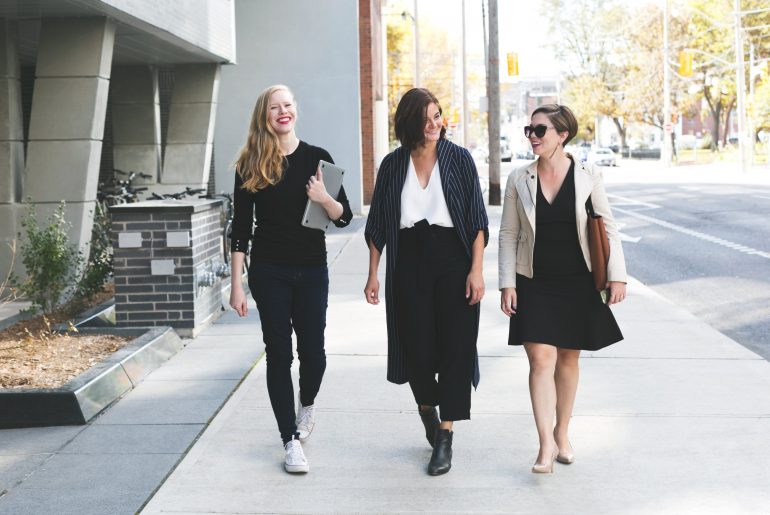This article is re-posted from a Sedentary Behaviour Research Network blog post on 3rd July 2019. Recently, research into the topic of excessive sitting, or “sedentary behaviour”, has been making headlines. The risk for chronic diseases, such as diabetes and obesity, that comes with high levels of sitting is becoming more evident (1). Office workers represent a population that spend a significant amount of time in sedentary pursuits as a consequence of their occupation (2). As more research is being published on the topic, many workplaces are seeking non-sedentary alternatives and solutions to the traditional office environment to keep their employees as healthy and productive as possible. One such solution has been the implementation of activity-permissive workstations. Activity-permissive, or alternative, workstations replace a worker’s traditional desk and are broadly categorized into either standing desks or dynamic workstations. Standing desks allow for a worker to stand while performing a task (e.g., typing, clerical work), and can be installed as additions to an existing workstation, or as height-adjustable replacement units (see Figure 1). Dynamic workstations are designed to allow for activity or movement while working, and include a variety of alternative workstations, such as: treadmill desks, cycling desks, and dynamic sitting desks…
“Sit less—move more and more often”: all physical activity is beneficial for longevity
This article was originally published in the BMJ Opinion on 21st August 2019. New research shows that any level of movement decreases risk of premature death, so get moving say Ulf Ekelund and Thomas Yates It is well established that physical activity of a moderate or vigorous intensity (such as brisk walking) is good for your health. More recently, it has also been shown that people in contemporary societies are spending the majority of their day sitting, and that this prolonged sitting is also linked to an increased risk for many chronic diseases and premature death. Current physical activity recommendations, including those recently updated for the US, suggest that at least 150 minutes per week of moderate intensity physical activity is needed to keep healthy and that prolonged sitting should be avoided. However, how much sitting is too much? This is not specified and is widely debated. In addition, are levels of physical activity below those recommended still beneficial for health and does light intensity physical activity still count? Answering these questions have huge relevance for health promotion. We performed a study to address these questions. Our results suggest strong associations between total physical activity and the risk of dying.…
Six Strategies For Sitting Less
Six Strategies for Sitting Less Scratching your head on how your team can BeUpstanding? A recent study by Hadgraft and colleagues and published in the journal BMC Public Health, explored office workers attitudes around reducing workplace sitting. They also sought out workers opinions on a variety of strategies aimed at reducing occupational sitting, which were commonly identified from previous workplace interventions, and their perceived barriers to achieving this in the workplace. A number of strategies were viewed as acceptable and likely to be adopted by workers with some of the strategies addressing multiple influences on sitting and catering to a range of different jobs and preferences. Why not give some of the strategies a try in your workplace! Make use of standing meeting. Sick of sitting through endless meetings? Look to change it up by changing your posture. A standing meeting can be used for a quick check in with the team, while putting stand and stretch breaks into the agenda can help your team reset and refocus. Why not step it up by having a walking meeting for those one-on-one catch ups! Communicating face-to-face. Whenever there’s a short message to be conveyed to a co-worker, employees can tell the…
Standing Up To Sedentary Working
The following article was written by Sophie O’Connell and published in Occupational Health and Wellbeing on the 7th June 2019. The modern world and the constant pursuit of technological growth have almost eliminated the need for movement in our daily lives. While commuting we sit in our cars or on the bus; at work we sit at our computers or in meetings; during our leisure time we sit watching TV, playing computer games or socialising with friends. Because of technology advancements we do not even need to leave the comfort of our own homes to socialise, stay in touch with friends and family, to shop, to work or even be entertained on a screen. This means that, on average, Brits spend around 9.5 hours a day spent sitting. Typically, the amount of time spent sedentary each day increases with age. In working-age adults much of this sitting is done at work. Evidence shows that office-based workers spend around 75% of their working day sitting, with a third of sitting time being done for a prolonged period. Many of us are guilty of spending time sitting for extended periods due to work, travel or various social commitments. But with the growing…
Forget Standing Desks: To Stay Healthy, You’ve Got To Move All Day
The following article, written by Christopher Keyes, was published by The Guardian on February 6th, 2019. If you want to dedicate yourself to a lifetime of good habits, don’t start at the gym. Start at the office. A few years ago, James Levine, a doctor of endocrinology at the Mayo Clinic, sparked a radical change in America’s office furniture. His research had inspired a pile of viral stories cataloging the negative effects of sitting at a desk: leg muscles shut down, blood pressure increases, good cholesterol plummets, your children starve. OK, I made up that last one, but the real takeaway was no less dire. “Excessive sitting is a lethal activity,” Levine, who has studied sedentary behavior for nearly 20 years and is the most widely quoted expert on the topic, told the New York Times in 2011. And the solution – at least the one people heard – was to start standing. Cue the office makeovers. Over the next several years, workers all across America embraced stand-up desks. At Outside’s headquarters in Santa Fe, New Mexico, our building manager furiously reconfigured work spaces. Desks were removed from their shelving brackets, raised a foot and a half, and remounted. Walking the hallways,…
US Physical Activity Guidelines (2nd Edition) Now Available
Have you heard? The U.S. Department of Health and Human services (USDHHS) recently released the updated guidelines on physical activity. As first reported by the USDHHS, here are the “Top 10 Things to Know About the Second Edition of the Physical Activity Guidelines for Americans” (psst make sure you check out #6). The second edition of the Physical Activity Guidelines for Americans provides evidence-based recommendations for adults and youth ages 3 through 17 to safely get the physical activity they need to stay healthy. There are new key guidelines for children ages 3 through 5 and updated guidelines for youth ages 6 through 17, adults, older adults, women during pregnancy and the postpartum period, adults with chronic health conditions, and adults with disabilities. The new key guidelines for children ages 3 through 5 state that preschool-aged children should be active throughout the day to enhance growth and development. Adults caring for children this age should encourage active play (light, moderate, or vigorous intensity) and aim for at least 3 hours per day. The recommended amount of physical activity for youth ages 6 through 17 is the same. Each day, youth ages 6 through 17 need at least 60 minutes of moderate-to-vigorous activity to attain the most…
Quick Tip – Water Bottle Replacement
Are you looking for ways to move more at work? Here’s one of our favourite tips to get you out of your seat and onto your feet. Replace your water bottle with a glass! This simple strategy forces you to stand up and walk to fill your glass every time it is empty. In addition, this is helpful because it helps remind you to drink enough water which is also important for your health. The most sustainable strategies are sometimes ones that will easily become part of your daily routine. An empty glass on your desk is a subtle reminder to stand up often. We hope this simple tip will have you up and moving about without even thinking about it. Happy moving!
Are competitions all they’re cracked up to be?
Nowadays it seems you can sign up to a team challenge for almost anything and there is a good reason why; friendly competition is a great way to boost engagement and help maintain momentum for change. When we talked to staff and champions nearly all of them said that team competitions like stepathons and stair challenges were (or should be) a key part of their BeUpstanding™ journey. So what’s the science behind competitions? Well, we know that peer support (or peer pressure?!) is a key technique for supporting behaviour change. As one staff member said I’m the type of person that needs to be reminded to do things for myself and my health. It was much easier with everyone being on board. I guess it was contagious.. in a good way What are you waiting for? Start a friendly BeUpstanding™ competition today! Sign up to the Toolkit now!
Moving every half hour could help limit effects of sedentary lifestyle, says study
Exercise is not enough to ward off the risks of sitting still for long periods of time, regular movement is key! This recent article in the Guardian highlights the latest evidence…
Scared? Sit Less! A message from our Healthier Workplace WA partners
Our partners over in WA from Healthier Workplaces have produced some great tools for raising awareness around the dangers of too much sitting. We love their SCARED SIT LESS video! We think you will too.









